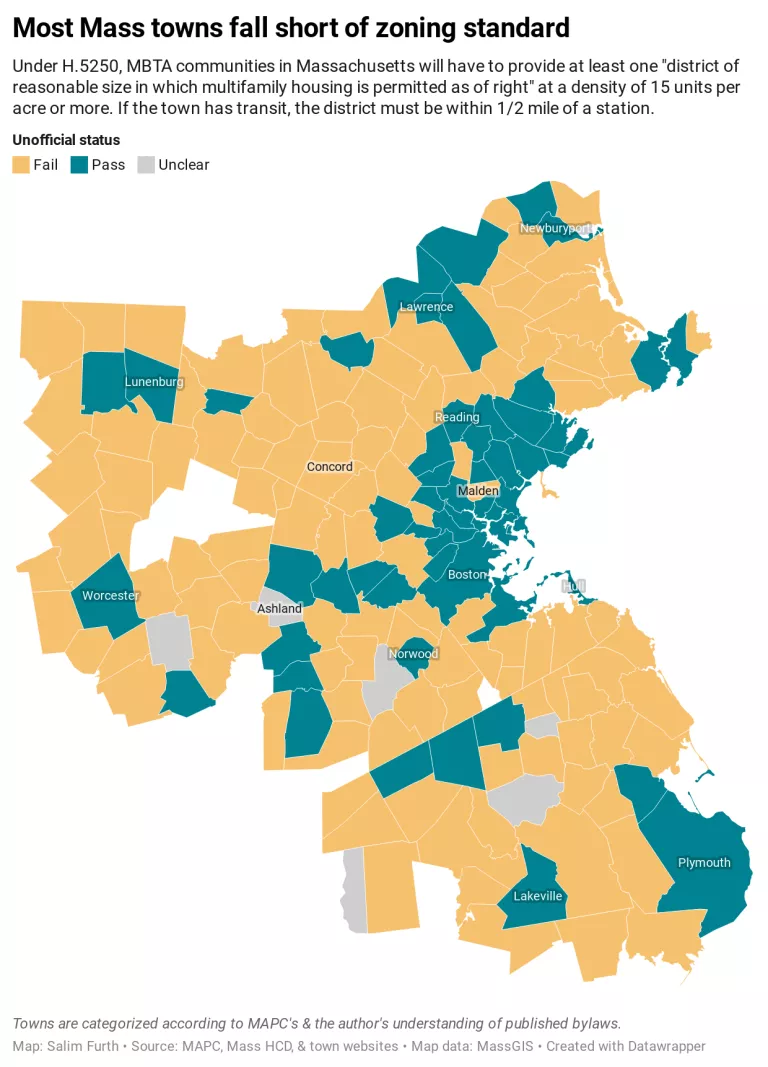- | Expert Commentary Expert Commentary
- |
Massachusetts Omnibus Law Will Result in Widespread Rezoning
Last week, Massachusetts legislators took a step to address housing scarcity in the Bay State, which has led to decades of rising home prices. Now signed into law by Gov. Charlie Baker, Section 18 of the state’s omnibus spending bill (H. 5250) heralds a new approach to local zoning authority, allowing localities deference in means but not the unlimited authority to exclude.
Section 18, which originated as standalone bills introduced two years ago, is a “choose your own adventure” preemption. It requires towns to provide some multifamily zoning but leaves them with ample latitude in how and where to do so.
Specifically, Section 18 requires that each of the 175 communities served by the Massachusetts Bay Transit Authority (most of Eastern Massachusetts) provide a zoning “district of reasonable size in which multifamily housing is permitted as of right”—that is, without a special permit. The district must allow housing not specifically reserved for elderly individuals, including units sized for families. In towns with a transit station or ferry terminal, the district must be within half a mile of the station.
Is My Town in Compliance?
To assist town planners and elected officials in identifying whether this bill requires a rezoning, I analyzed zoning maps and bylaws provided by the Metropolitan Area Planning Council and individual towns. Town officials can consult an interactive map hosted by Datawrapper to learn whether or not their town appears to be in compliance.

I did not take into account the “reasonable size” requirement of Section 18. In Hull, for example, a tiny strip of land beside the ferry terminal is zoned Commercial Recreation B, which allows up to 18 residential units per acre and thus meets the law’s requirements. In Norwood, the qualifying “district” consists of a single building on Guild Street. The commonwealth may give a substantive interpretation to “reasonable size” that renders Hull and Norwood noncompliant.
Most Towns Will Need to Rezone
The number of towns that are not in compliance came as something of a surprise to this Boston native. Many towns with an existing multifamily housing stock do not allow multifamily buildings by right on those sites. Malden, for example, has a downtown full of large, mid-rise apartment buildings, some built in the past few years. But the town requires a special permit for even a three-family house.
Of the 175 cities and towns affected, at least 115 will require a rezoning to come into compliance. In five more towns, I was not able to determine whether the town was in compliance. One of those, Ashland, has a downtown district that allows dense multifamily housing. However, Ashland’s commuter rail station is half a mile west of the downtown. Without further legal interpretation, I cannot determine its compliance status.
Overlapping Laws
Section 18 interacts helpfully with two other state laws intended to boost housing opportunities in more areas. One is Gov. Baker’s Housing Choice Initiative, key aspects of which are included as sections of H. 5250. While most rezonings in Massachusetts require a two-thirds vote of town meeting—an extraordinarily high bar to pass—the Housing Choice Initiative lowers the threshold to a simple majority for specific types of upzoning. Now that both Section 18 and the Housing Choice Initiative have become law, the latter will make it much easier to implement the former.
Secondly, Massachusetts has offered towns a “smart growth” zoning incentive known as Chapter 40R since 2004. Under Chapter 40R, the state rewards towns for allowing dense mixed-use and multifamily zoning (usually 20 units per acre or more). Many suburbs, such as Lakeville, Newburyport and Reading, are already in compliance with Section 18 because they previously used Chapter 40R.
With the enactment of Section 18, expect many more towns to adopt “smart growth” zoning under Chapter 40R. In many cases, Chapter 40R has been applied to specific projects on unique sites where redevelopment is badly needed. In Lunenburg, for example, the smart growth district allowed an apartment complex to replace the Tri-Town Drive-In Theatre.
Conclusion
As law professor John Infranca has argued, state preemption of local zoning authority is effective when it is simple. Massachusetts’ experience has borne that out: Amy Dain found that only a trivial share of multifamily housing in Greater Boston comes via the complicated Chapter 40R. Section 18 is not immune to the travails of previous state actions.
However, Section 18 has the opportunity to preserve the best aspects of federalism, allowing town officials to use their local knowledge to guide and incorporate multifamily housing, but preventing them from using their authority to entirely prevent change.
If Section 18 is thwarted by towns responding in bad faith, expect the next round of state preemption to be stronger and leave less of a role for towns.
This piece was originally published on January 14, 2021, and updated on January 15, 2021.